I’ll tell ya, the man who operates the once-daily tourist bus between Petra and Wadi Rum is not a very nice man.
First of all, there are no publicly advertised bus services between Jordan’s twin desert wonders. You’d imagine that a bus company shuttling between these two places would easily rake in the profits, but nope – the only way to get between the two places if you don’t have a car or a driver is to take a rickety tourist bus running once per day in either direction, which you must arrange with your hotel or camp in either Petra or Wadi Rum the night beforehand.
Since there’s no bus schedule or anything, there’s no indication of how much the two-hour bus journey costs. The TripAdvisor reviews, however, revealed that the bus is supposed to cost 7 JD ($13) per person, although the bus conductor can and will try to overcharge everyone onboard and ask for 10 JD ($19) instead.
(I tried to confirm the price with the staff member at the Marriott Petra’s front desk when arranging the bus ride, who gave me a telling smile and said “the driver will tell you the price”.)
Now, I’m not usually one to squabble over a few bucks, but after reading many fellow travellers’ accounts about the bus conductor’s predatory behaviour (such as shouting angrily at passengers who only paid 7 JD and spewing vitriol at passengers who tried to warn fellow travellers that they should only pay 7 JD), I decided that, out of principle alone, I was going to stick to my guns and only pay 7 JD per person for the journey, come what may.
And oh boy did a lot of things come.
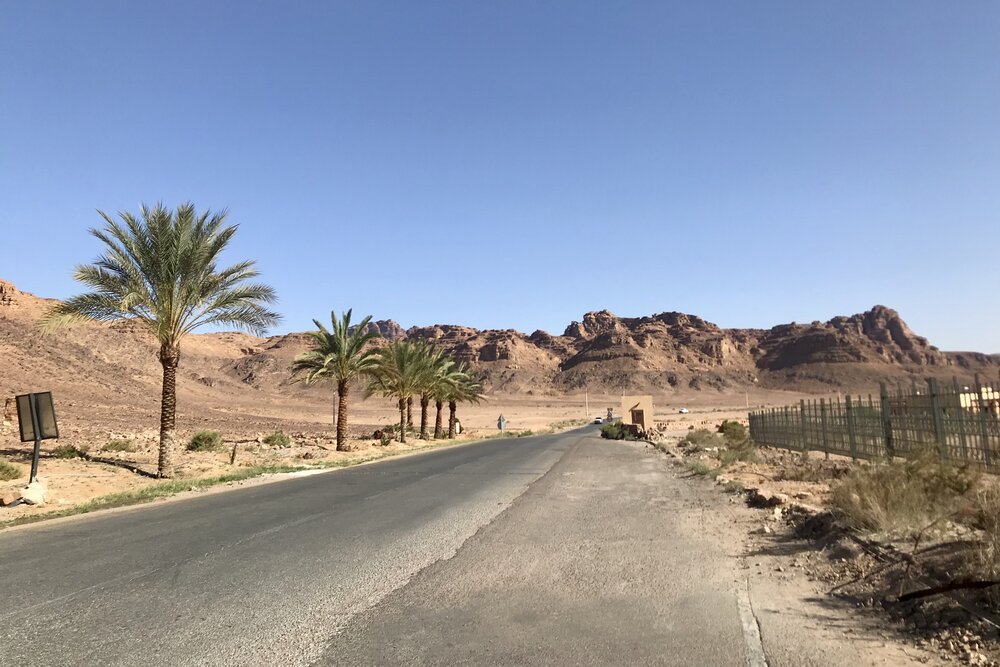
Driving to Wadi Rum
The journey to Wadi Rum was smooth enough, but when we got off and it was time to pay, I quickly found myself embroiled in an almighty shouting match with the bus operator.
He first insisted that I should pay 10 JD, and when I showed no sign of relenting, he told me to at least pay 8 JD, with the extra 1 JD for “the cost of bringing our bags”.
I wasn’t about to give in to his underhanded tactics, and continued to insist on paying no more than 7 JD. Eventually, it was he who took the moral high ground, asserting that he “[does] not need my money”, swiping the 14 JD out of my hand and walking away without another word.

Needless to say, paying an extra couple of Jordanian dinars wouldn’t have broken the travel budget. But as I’ve mentioned a few times when talking about Jordan, I did feel a pervasive undercurrent of… price discrimination during my time in the country, as though everyone working in tourism had the edge in squeezing money out of tourists, and that I was just very slightly being ripped off on every transaction, everywhere.
You guys know me, and you know that I’m all about doing my best to conform to the local customs and ways of life when I go somewhere new. I was happy to brush off the feeling as “oh hey, that’s just the way things are around here” or “these guys need to feed their families after all…” the first few times it happened, but after so many transactions that left me questioning the legitimacy of the price, I eventually felt compelled to play a little hardball of my own.
Anyway, as I stood there at the Wadi Rum visitor’s centre, wondering if I could’ve handled the situation with a little more class, I was soon approached by Mohammed from the Wadi Rum Bedouin Camp, the desert camp that we had booked for the night.
Mohammed wore a face of melancholy, as though he had witnessed the foregoing argument between headstrong tourist and predatory bus operator a thousand times before, and his arrival marked the flittering away of any negative feelings we had and the beginning of the most magical part of our time in Jordan.
The Best of Wadi Rum
If Petra were a window into the ingenious craftsmanship of ancient humans, then Wadi Rum is a similar portal into the even more awe-inspiring handiwork of Mother Nature.
But not the Mother Nature that you’d ordinarily picture in your mind – you know, lush tropical forests with waterfalls and such – but instead a much more eccentric variant, a post-menstrual Mother Nature if you will, whose conception of beauty takes the form of beastlike pink and crimson sandstone mountains slouching across a barren desert landscape hundreds of thousands of acres wide.

Driving into Wadi Rum Protected Area
Indeed, I struggled to make sense of what lay before my eyes as Mohammed drove us away from the visitor’s centre and into the Wadi Rum Protected Area, where we’d be spending the next day and night. Any semblance of civilization faded away immediately as we turned left off the main road and made our way towards the camp, and Jordan’s ancient desert, so striking with the reddish-orange hues of its sands, now stretched as far as the eye could see.
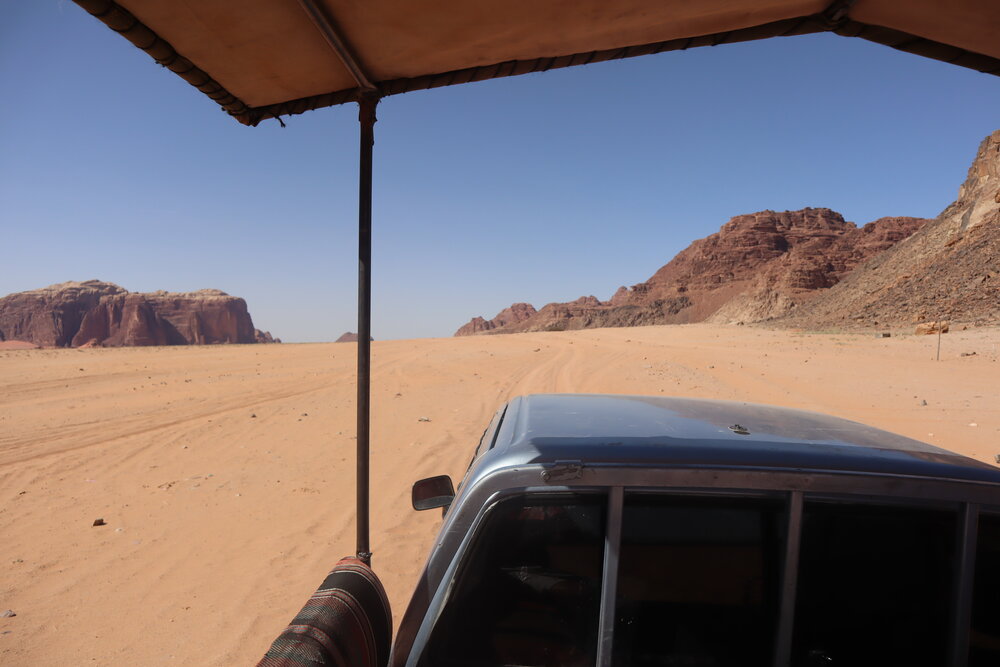
Driving into Wadi Rum Protected Area
Mohammed dropped us off at the camp, where we were introduced to our tour guide for the day.
Normally, the Wadi Rum Bedouin Camp – one of the most popular among the many overnight camps operating in Wadi Rum – offers a variety of tour options for their guests, such as Half-Day Jeep Tours, One-Day Jeep Tours, and One-Day Camel Tours.
During the holy month of Ramadan, however, the tour guides were only able to run half-day tours while fasting, so that’s what we ended up booking, for a total of 60 JD ($112) per person including the overnight stay, dinner, and breakfast.
Our Jeep tour brought us to some of the most famous sites within the vast Wadi Rum desert.
First up was Lawrence Spring, one of the few water sources in the desert, so named after T. E. Lawrence, the British officer who routinely passed through Wadi Rum during the Ottoman battles of the First World War, and whose story was later made into the film Lawrence of Arabia.
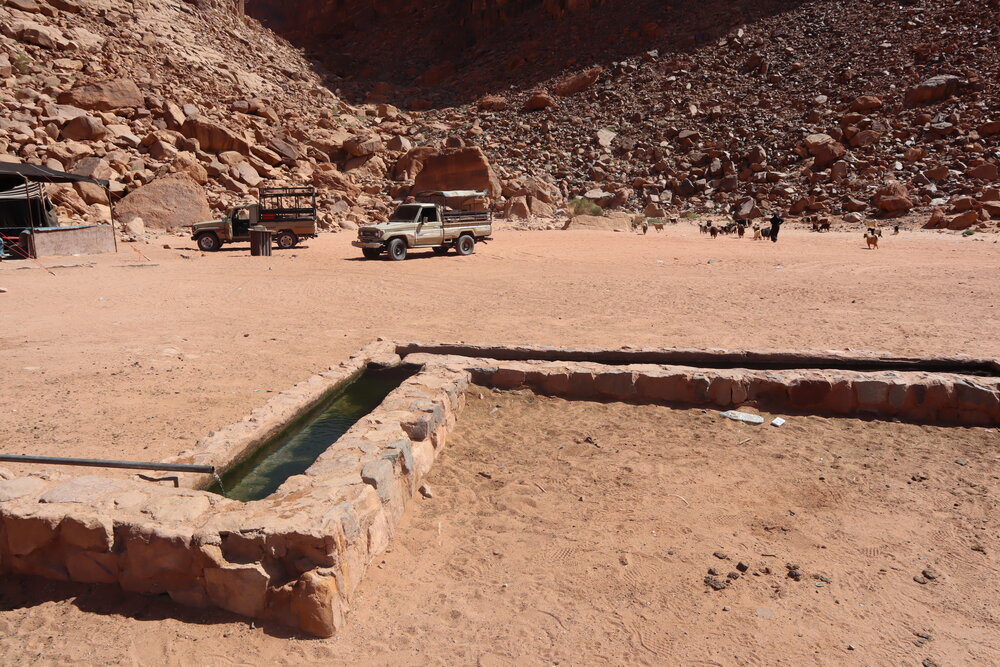
Lawrence Spring
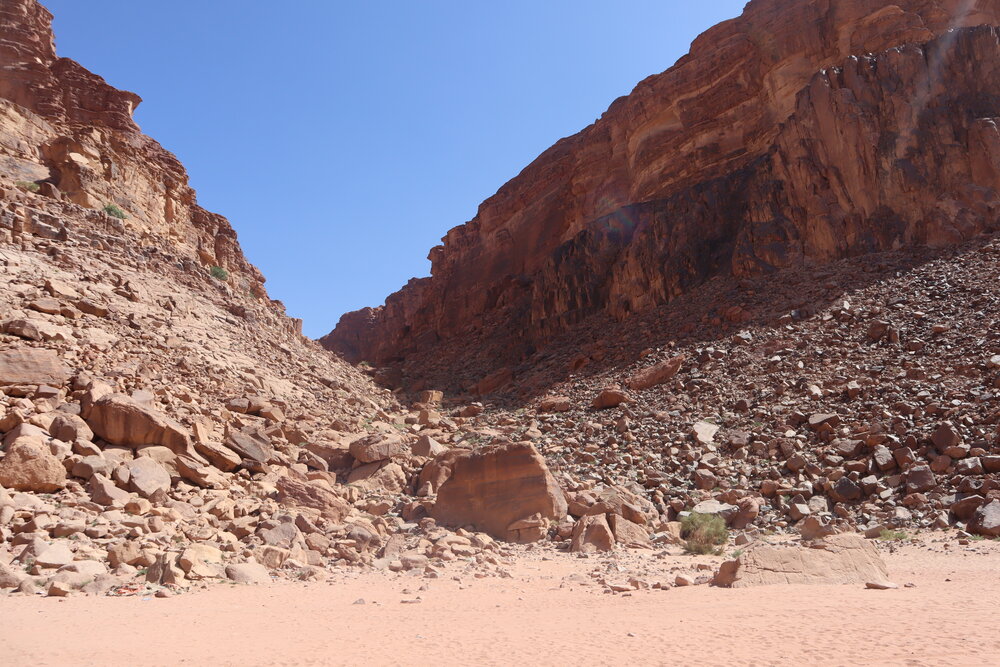
Valley near Lawrence Spring
Symbols from the Nabatean script dotted the rocks of the desert, serving as a reminder of the powerful civilization that inhabited these lands around 2,000 years ago.
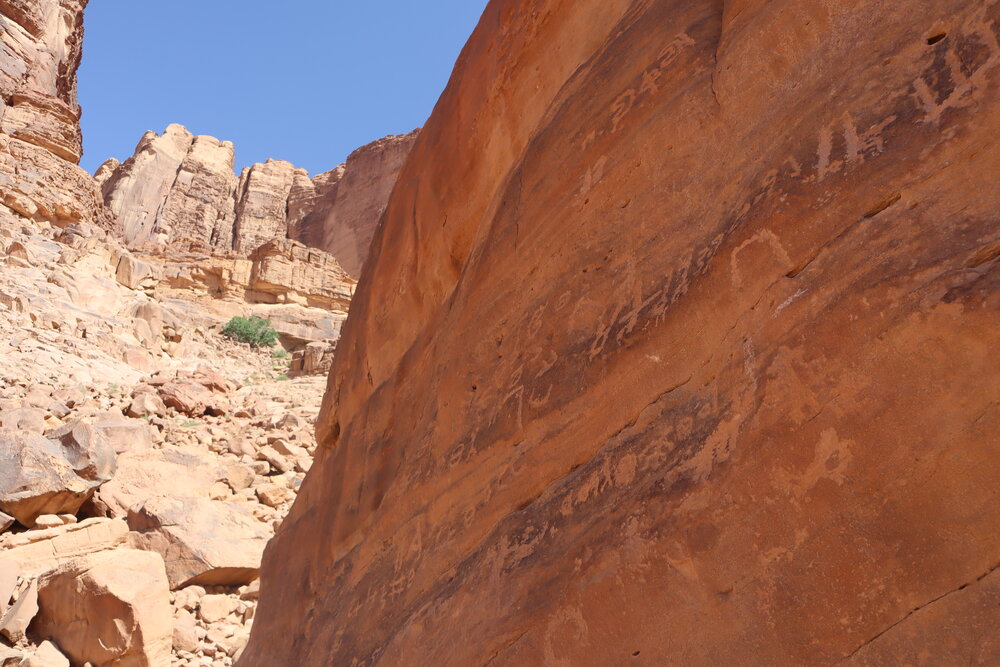
Nabatean inscriptions on the rocks
After the Lawrence Spring, a quick ride on the Jeep brought us to the red sand dune, a gigantic sand dune about the height of a five-storey building.
This was mostly a pit stop for recreational purposes, as Jessy and I climbed all the way to the top in our bare feet, getting up close and personal with the Wadi Rum desert’s distinctive red sands, before – you know it – letting our bodies loose and hurtling downhill at full speed.
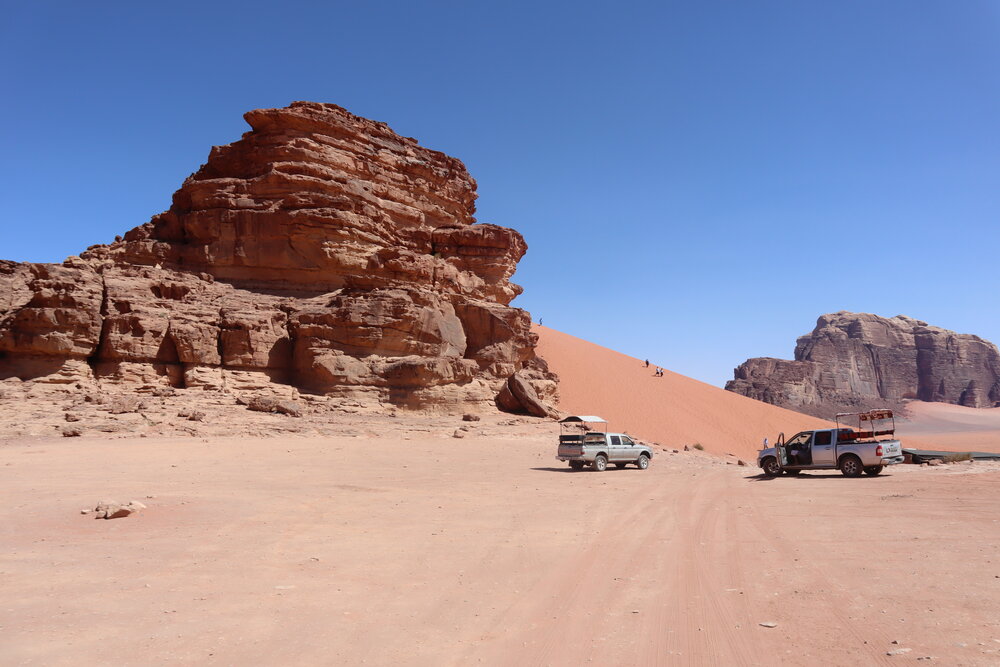
Red sand dune
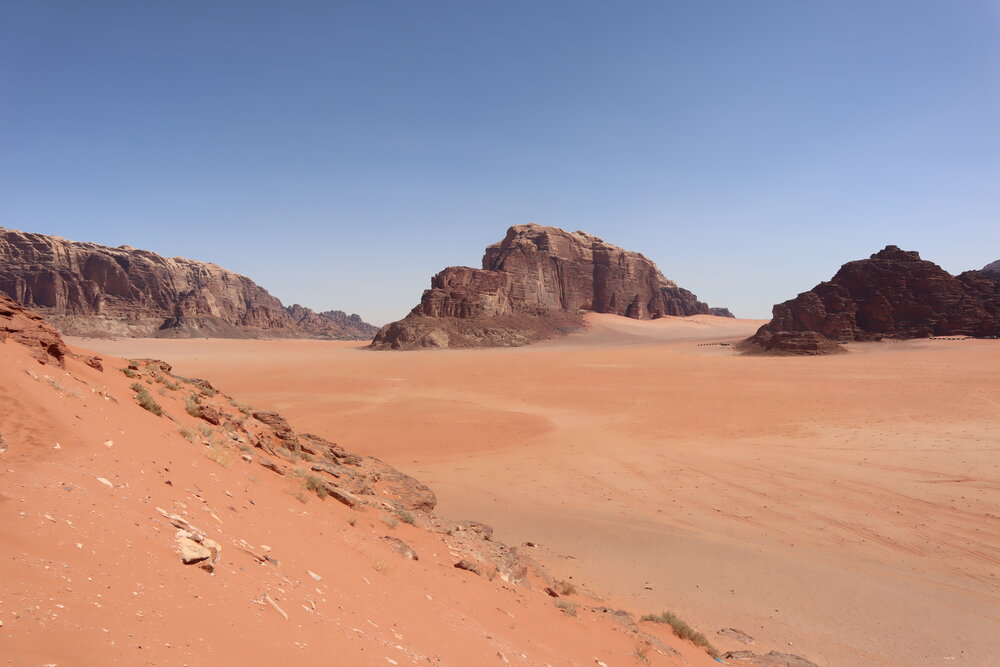
Climbing the red sand dune
Up next was the Um Fruth Rock Bridge, an example of the spectacular natural formations that pepper the landscape.
Here we have a natural archway that has been shaped by the elements over the centuries, with the softer rock at the lower levels having been eroded away by the relentless desert wind, until an opening formed underneath the harder layer above, creating the natural rock bridge.
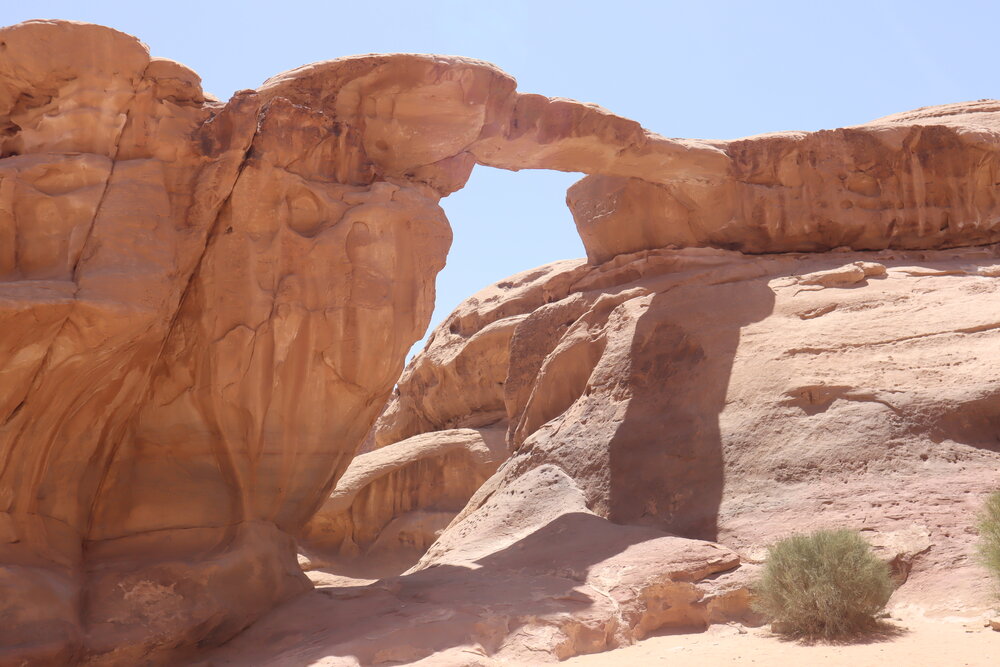
Um Fruth Rock Bridge
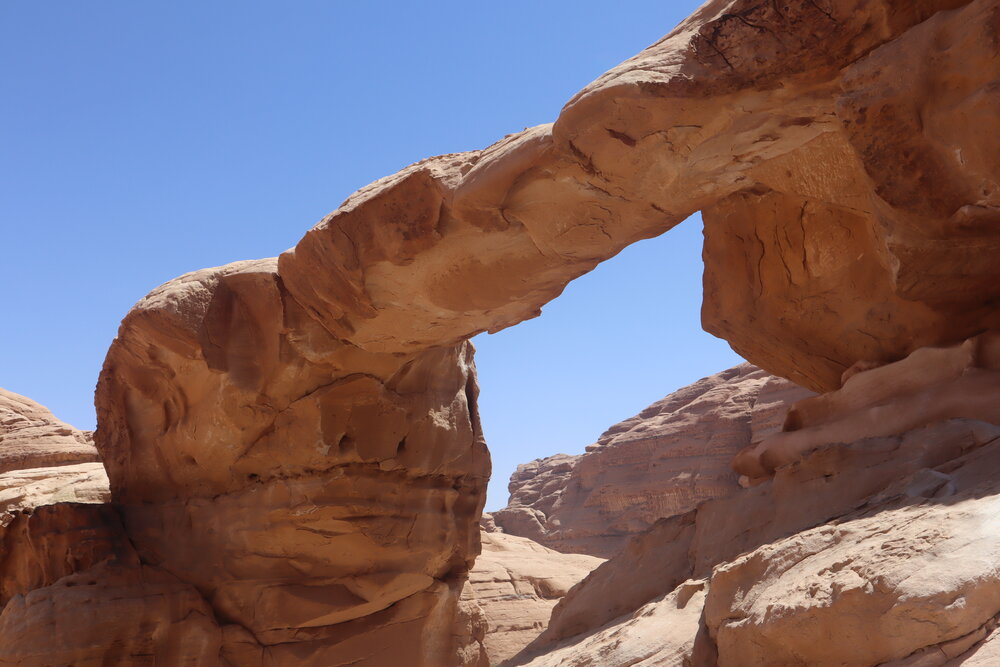
Um Fruth Rock Bridge
Jessy and I climbed the rather precipitous rock surface to the side to see the views from up there. In the meantime, our guide took a moment to take his Ramadan mid-day nap in the nearby tent, and we retreated there afterwards as well to briefly escape the sunlight with some warm Bedouin tea.
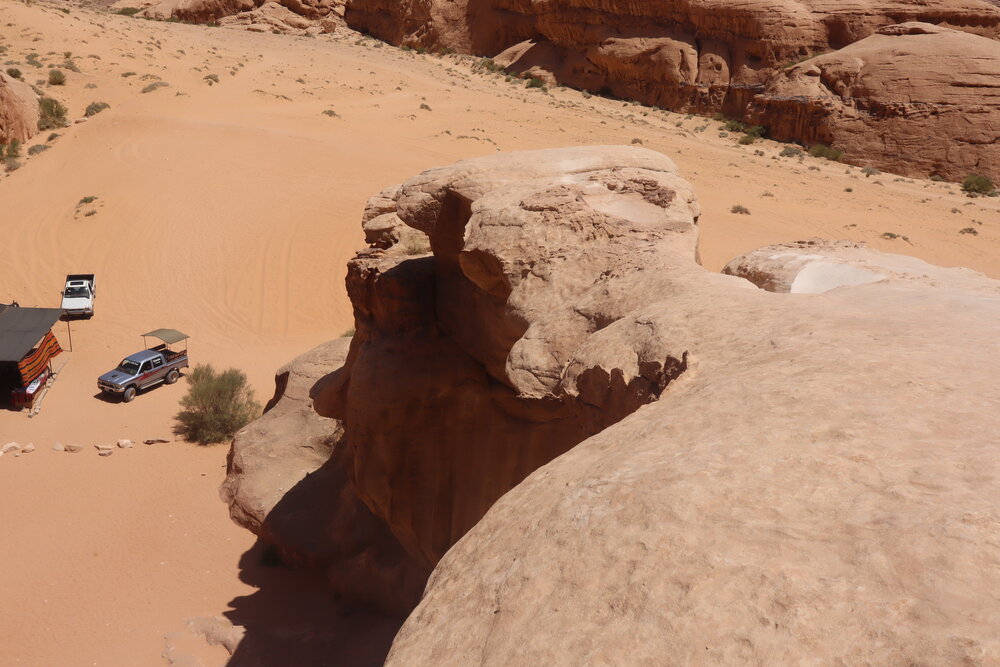
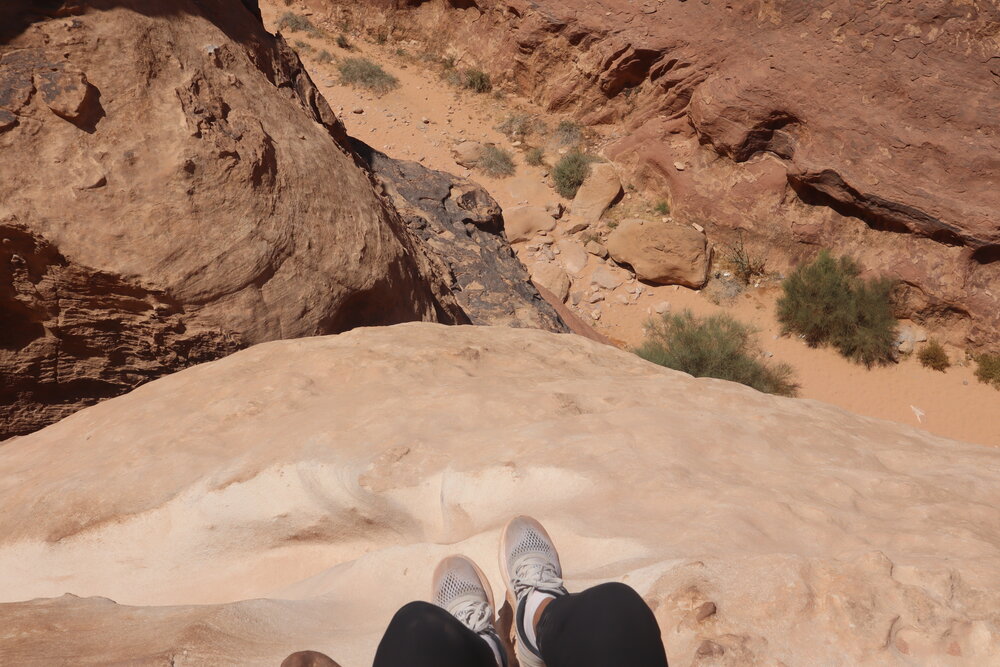
Finally, we hit the Khasali Canyon, a stunning narrow gorge between two sandstone cliffs a few feet from each other.
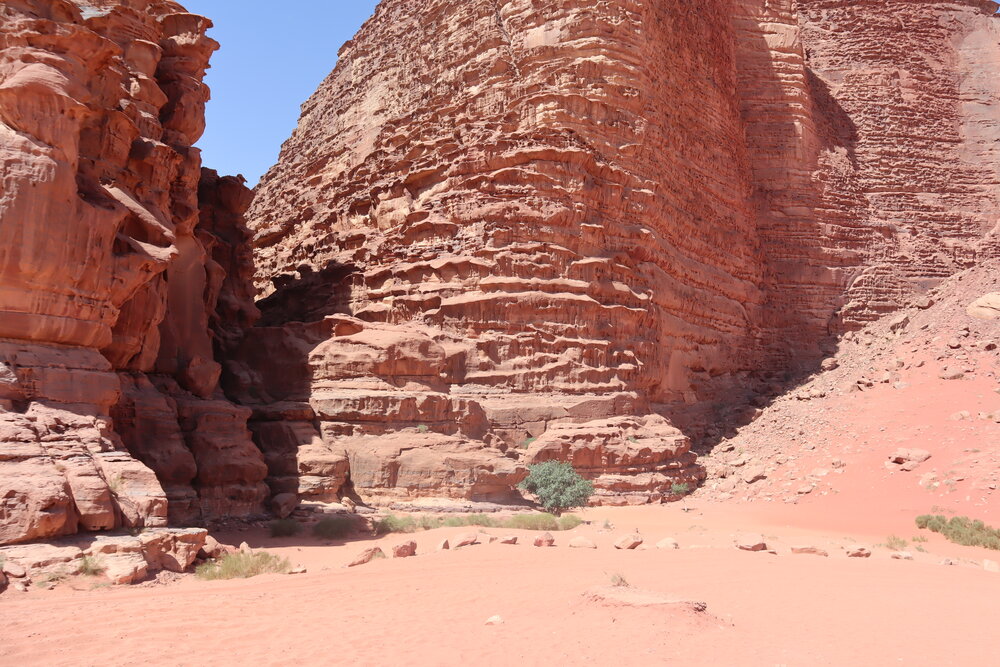
Khasali Canyon
The entrance to the canyon is particularly dramatic in its beauty, with the jagged rock face again evoking that sense of unconventional beauty.
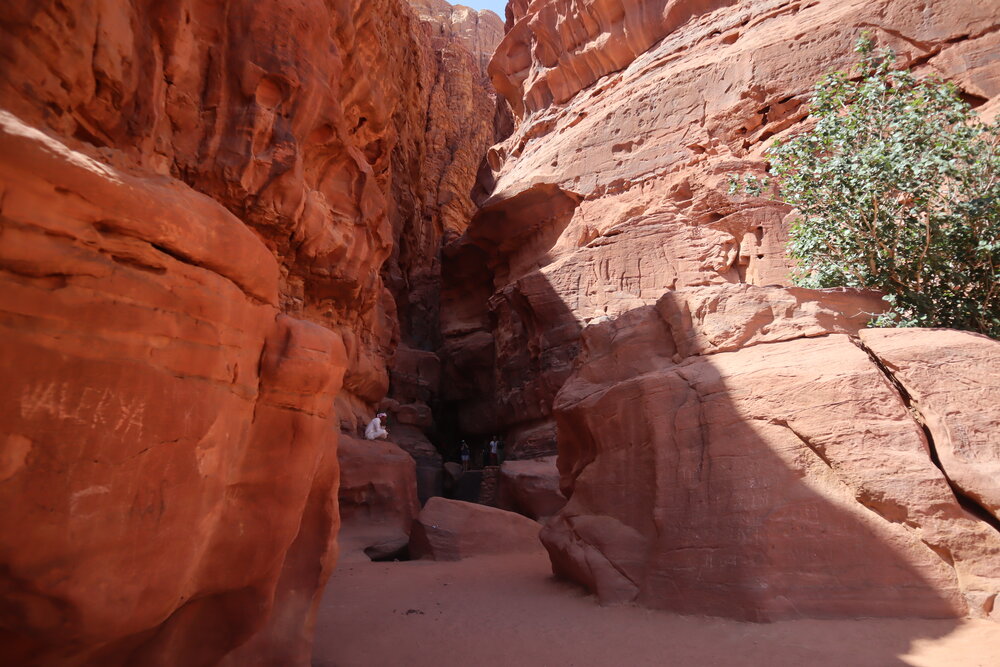
Khasali Canyon
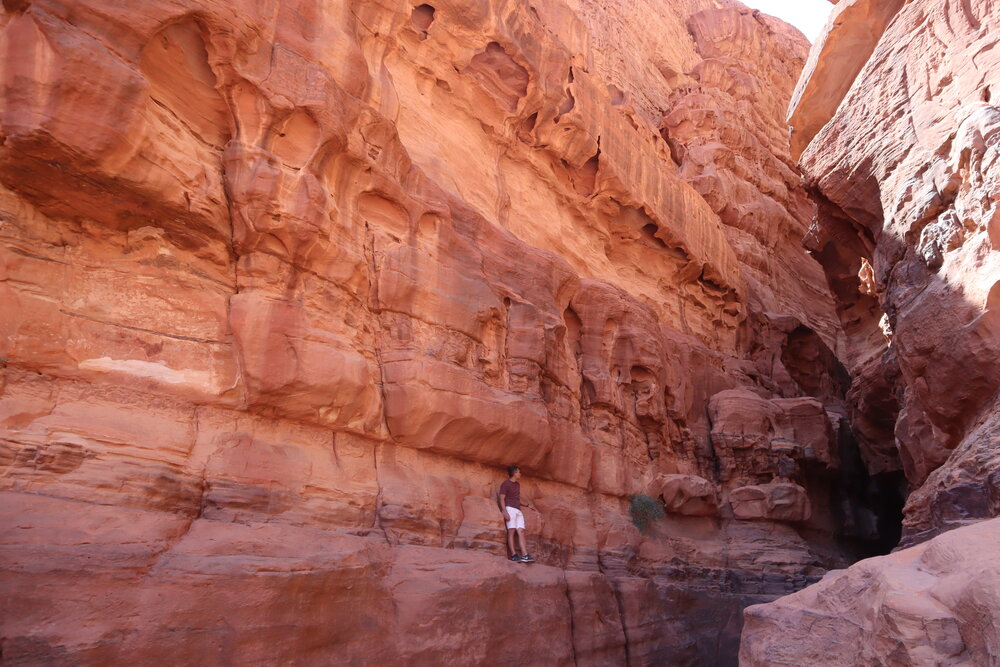
Khasali Canyon
Indeed, the longer I spent looking at the gargantuan and grotesque rocks, the more I concluded that this place was so downright ugly that it became its own kind of beauty, if that makes sense. This place had been billed as the “Mars on Earth”, and I honestly couldn’t think of a more apt description.
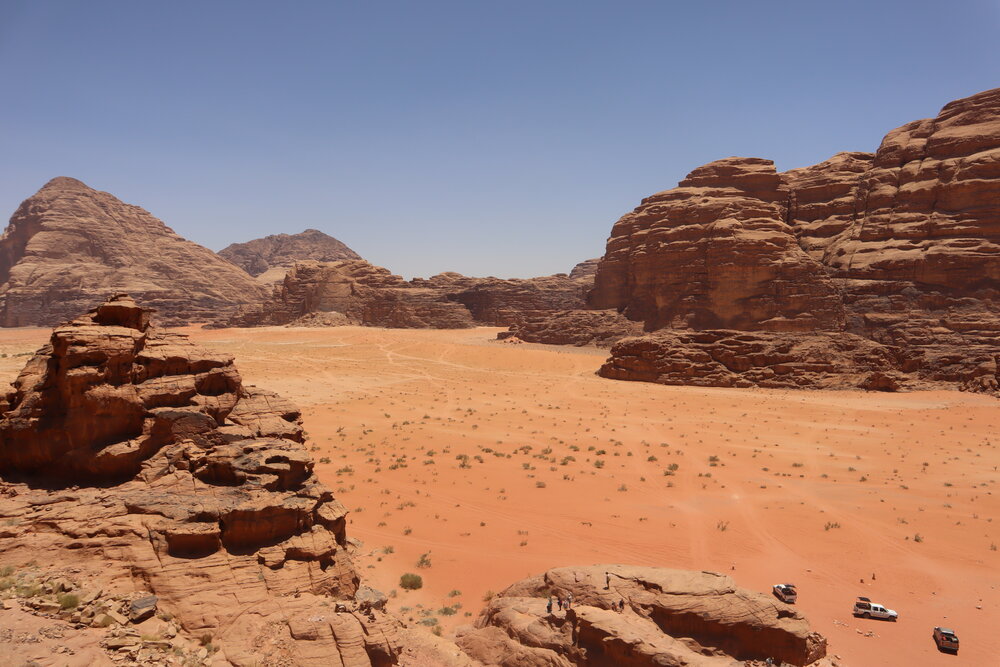
View from atop the rocks of Wadi Rum
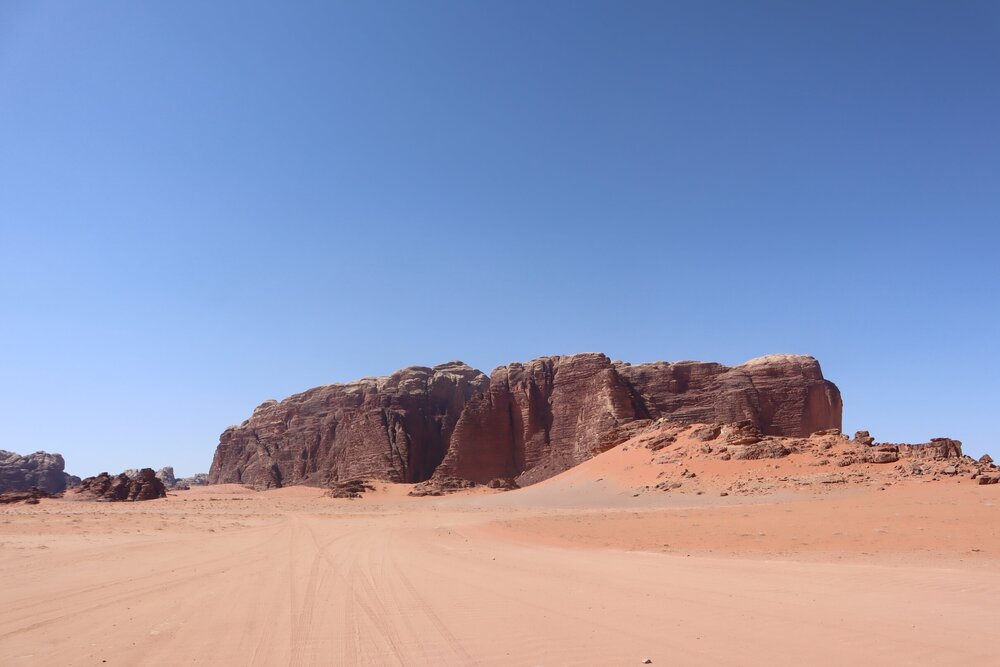
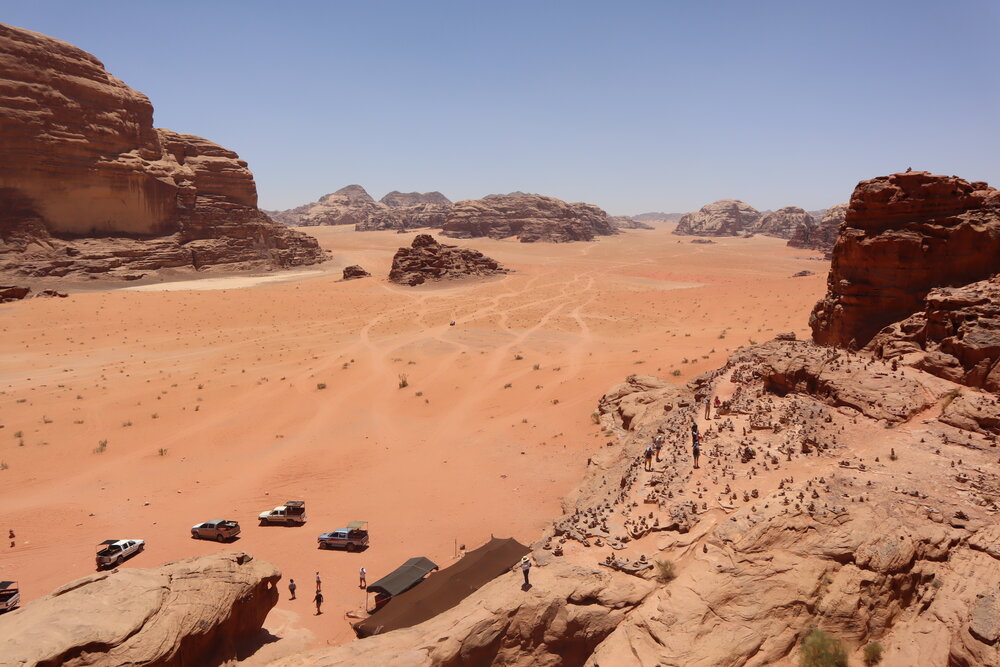
Wadi Rum Bedouin Camp
After our half-day tour, we retreated to the Wadi Rum Bedouin Camp to relax for the rest of the day in the peace and quiet of the desert.
We had been assigned Room 3 at the camp, which featured nothing more than a queen-sized bed. The camp’s tents are made of goat hair, and are set on stilts above the ground to prevent sand from getting all over the place.
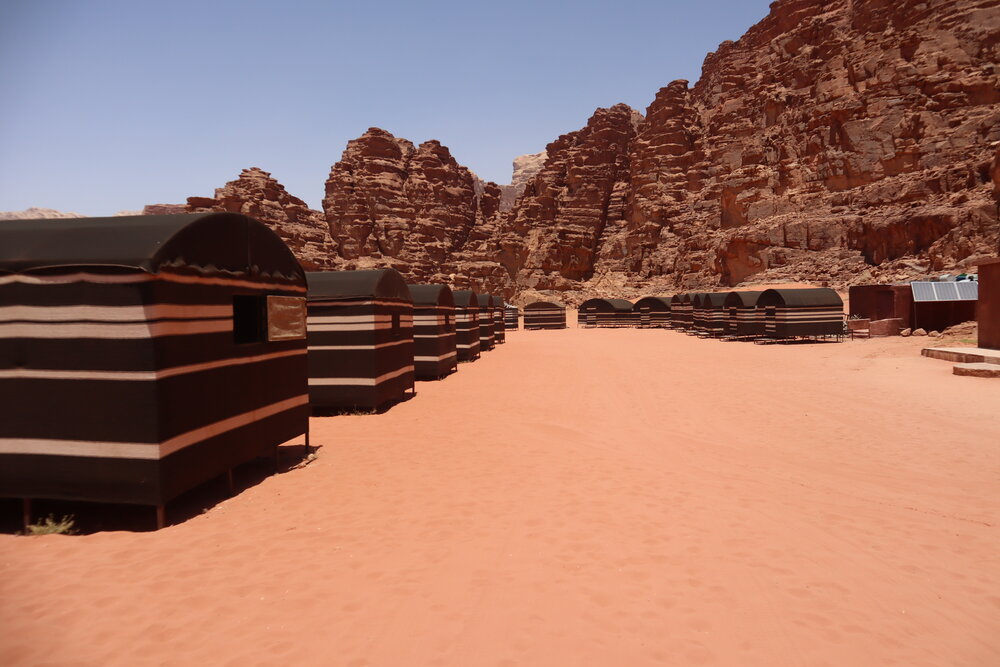
Wadi Rum Bedouin Camp – Camp grounds
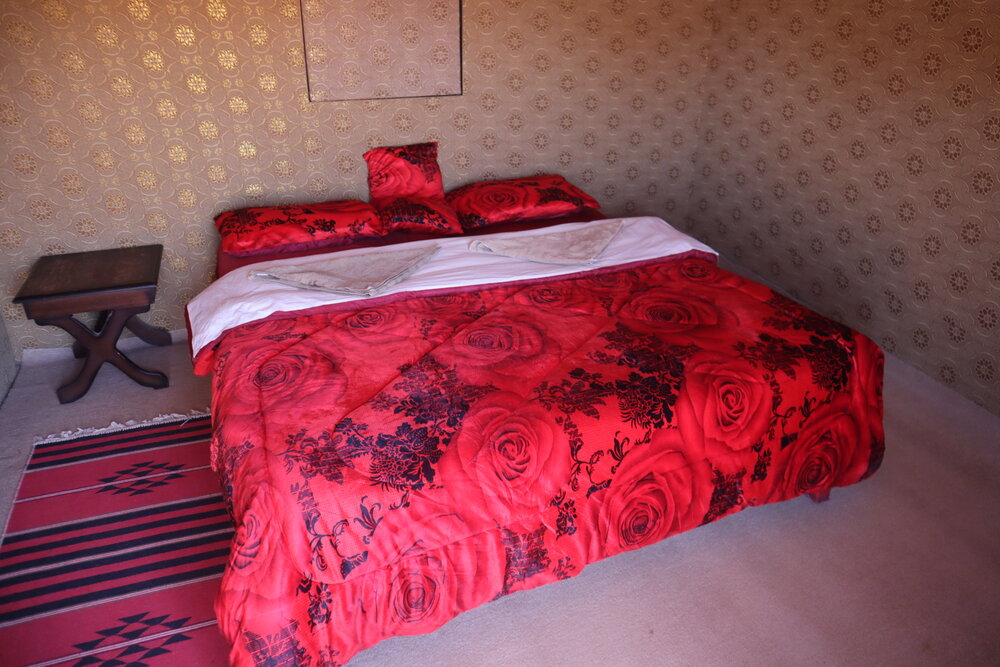
Wadi Rum Bedouin Camp – Private tent
Guests at the camp can make use of the shared toilet and shower facilities, which were in pretty decent condition – very much on par with your average camping facilities you might find back at home.
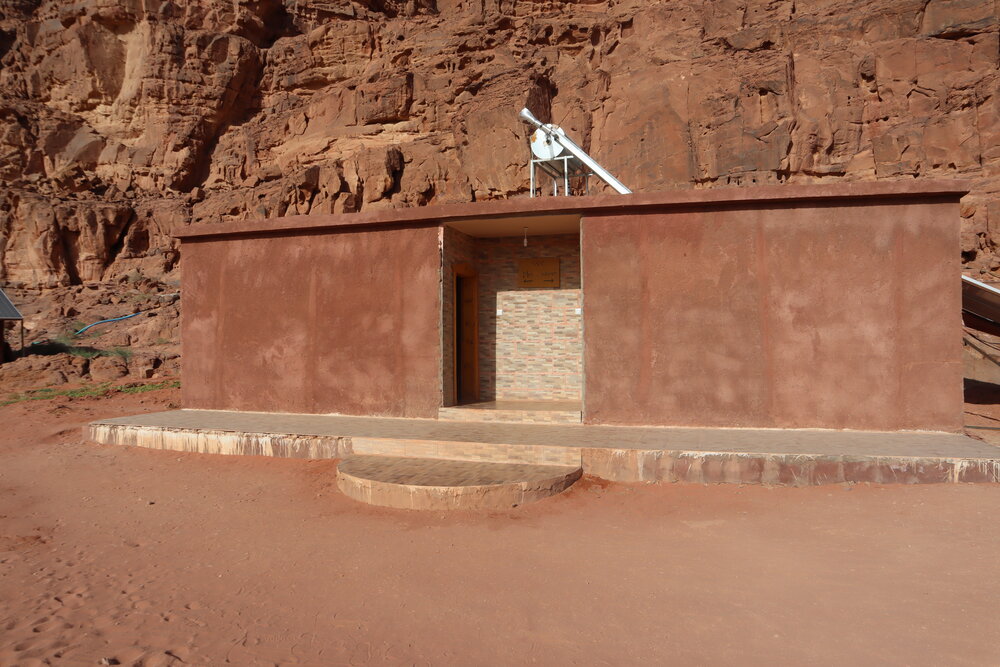
Wadi Rum Bedouin Camp – Shared bathroom
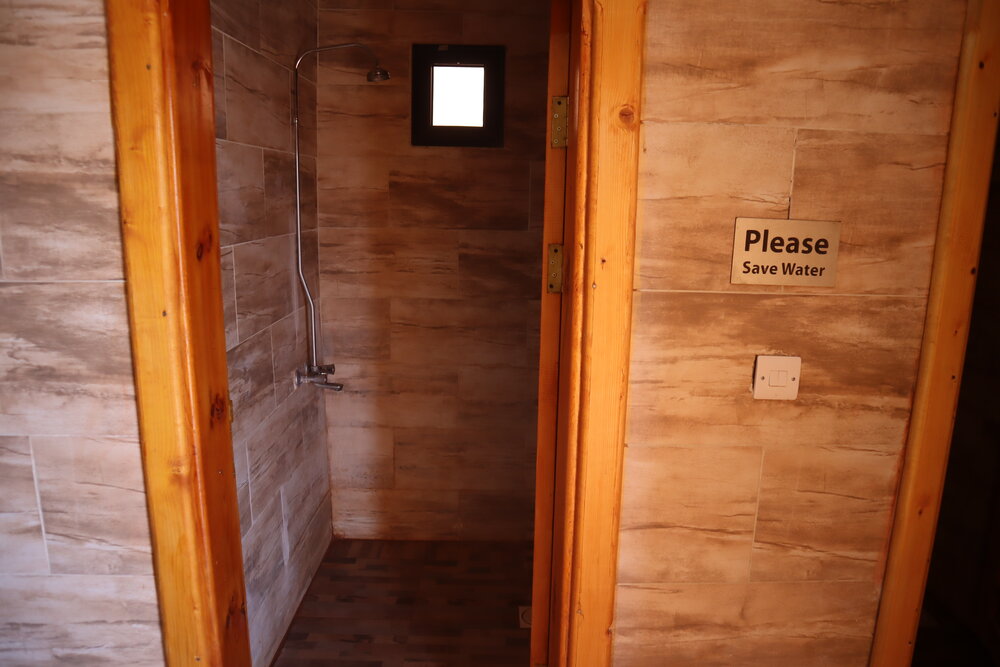
Wadi Rum Bedouin Camp – Shared shower facilities
We spent most of our time hanging out in the common tent, a large space with ample seating along the walls and a traditional tea presentation area in the middle, and was readily equipped with bottled water and power outlets.
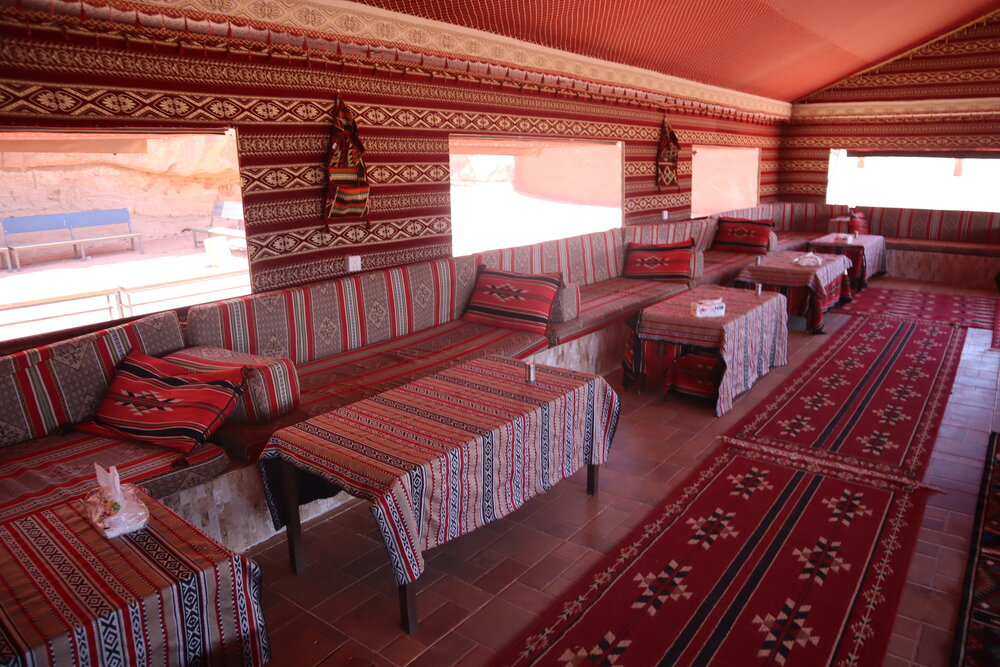
Wadi Rum Bedouin Camp – Common tent
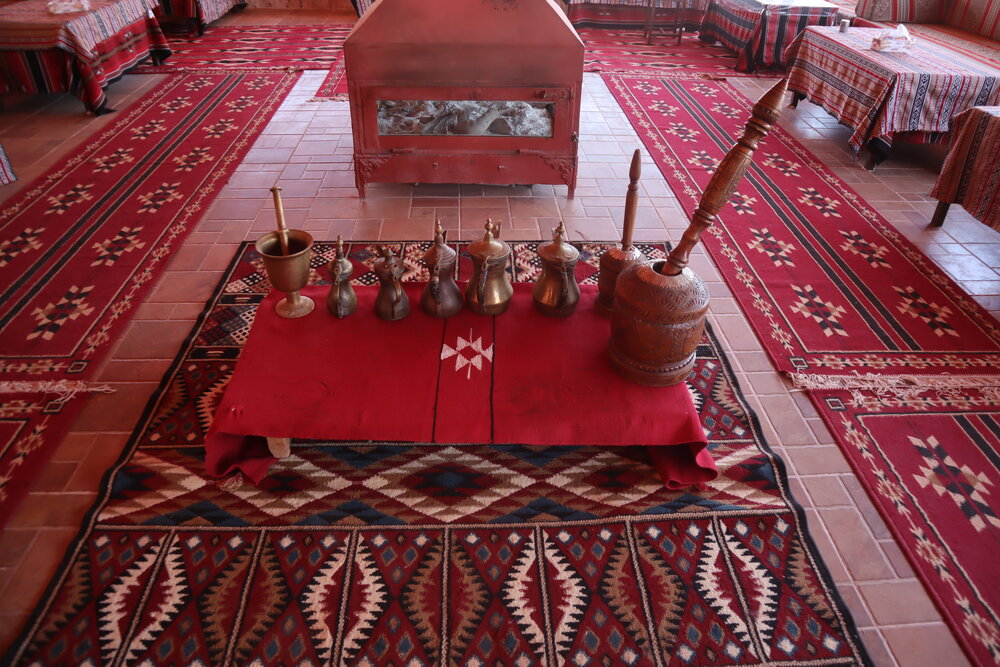
Wadi Rum Bedouin Camp – Common tent tea presentation

Wadi Rum Bedouin Camp – Common tent charging station
The Wadi Rum Bedouin Camp is situated in the shadow of a large rock cliff, and Jessy and I climbed up to the top to catch the sunset, of course accompanied by all of the other guests who are staying the night.
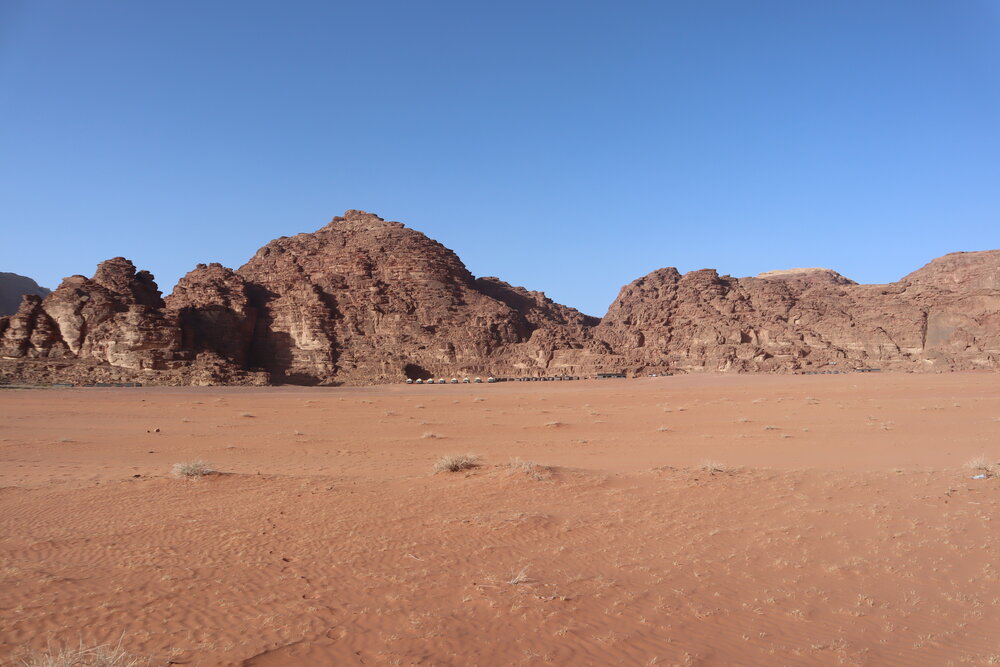
Wadi Rum Bedouin Camp from afar
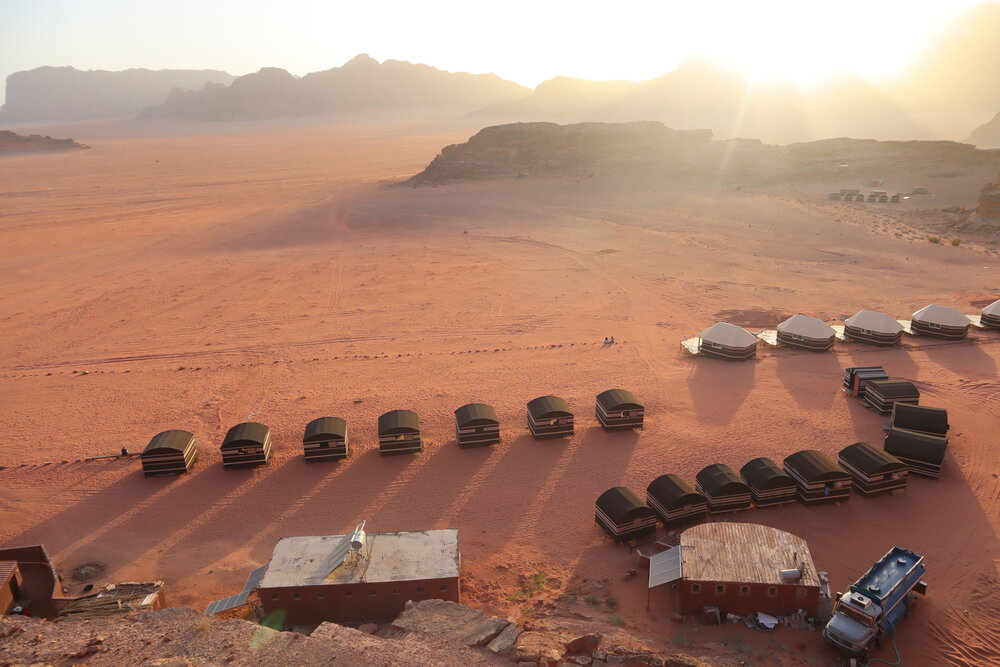
Wadi Rum Bedouin Camp sunset view
As we guests took in the sunset view, our hosts were busy preparing the traditional Bedouin dinner, which is cooked in a zarb, or an underground oven beneath the sand, for several hours.

Traditional Bedouin dinner at Wadi Rum Bedouin Camp
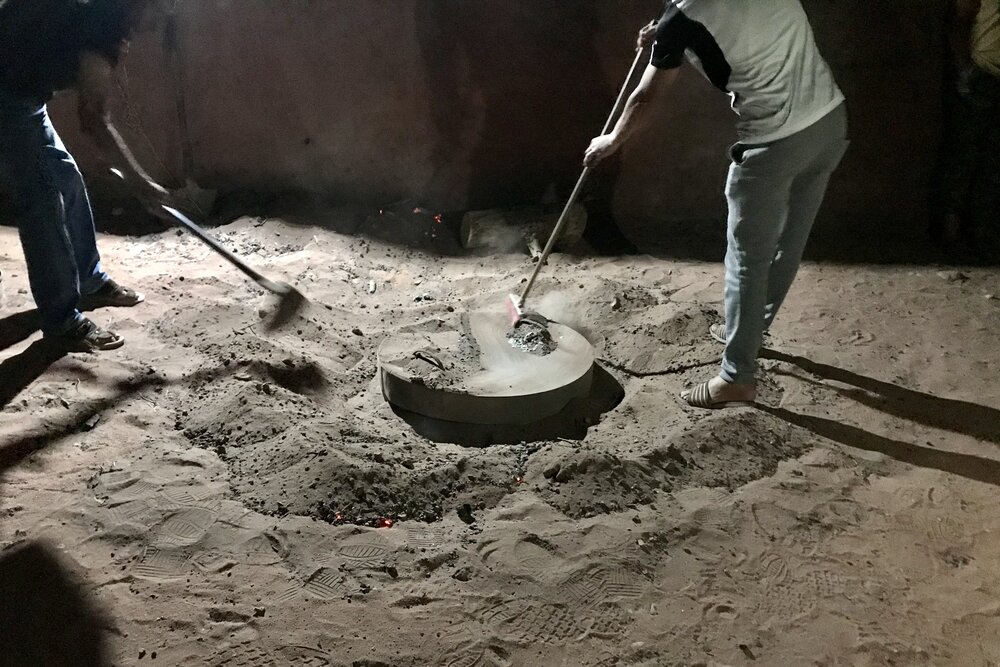
Traditional Bedouin dinner at Wadi Rum Bedouin Camp
The laborious cooking process does a wonderful job of bringing out the delicious flavours of the ingredients, and the resulting dinner buffet gave us by far the most memorable meal of the trip so far.
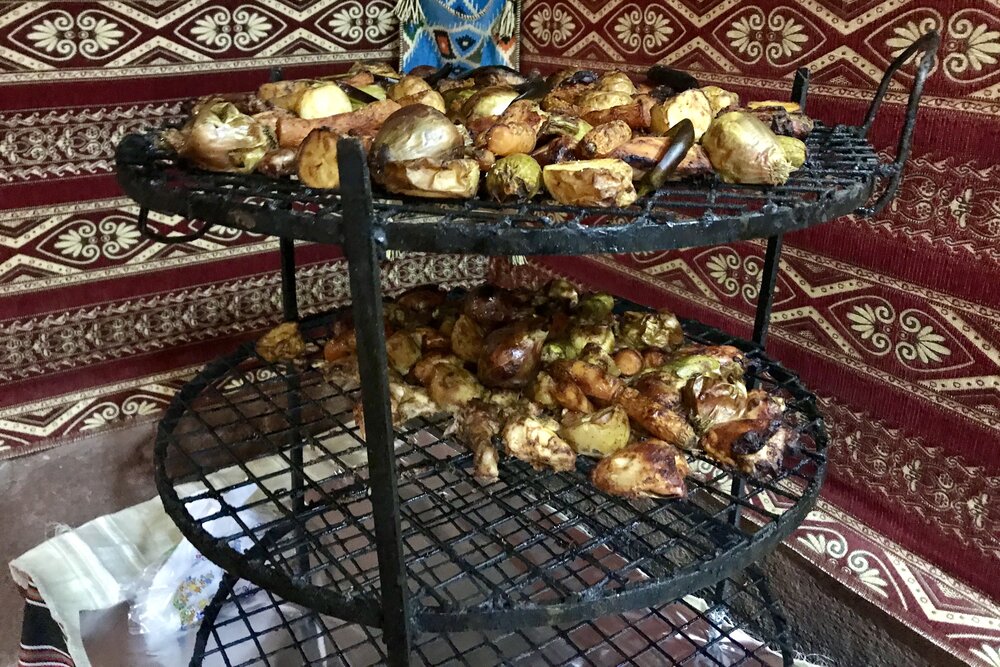
Dinner on the Zarb at Wadi Rum Bedouin Camp
After dinner, we sat by the outdoor campfire to chat with the other guests for a while before settling into our room for the night. Looking out into the distance from our front porch, I could see nothing but the silhouettes of the rock formations sleeping under the soft moonlight. The sand was cold under my feet now, and besides the light desert wind whistling through the mountains, it was eerily quiet.
Mars on Earth, indeed. What a truly incredible place.
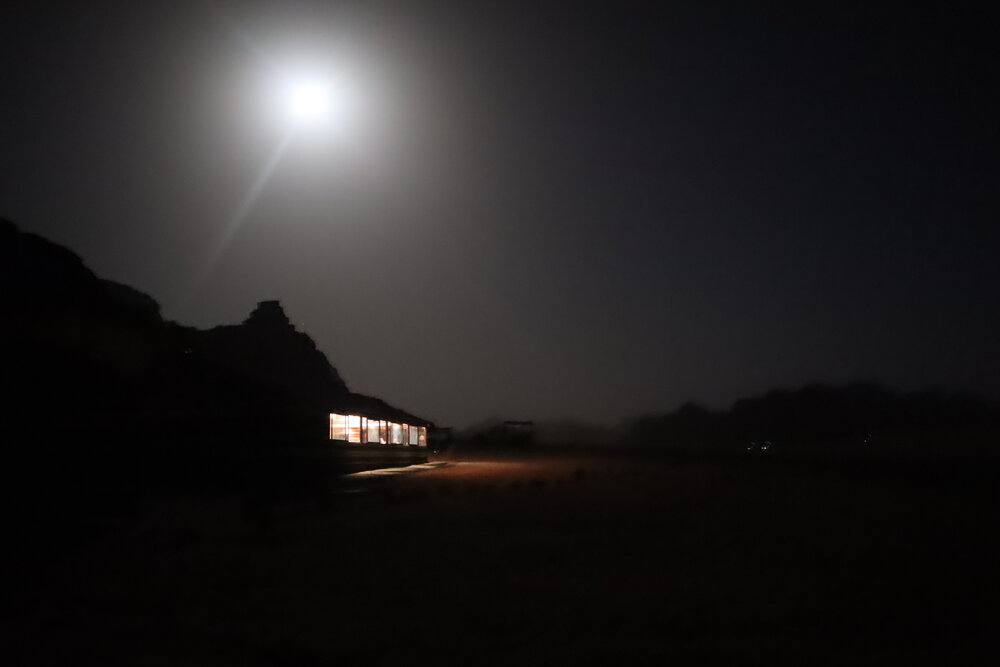
Wadi Rum Bedouin Camp by night
As I stood there in the darkness gazing upon the jagged silhouettes in the distance, I felt genuinely lucky to have had the chance to see this unique slice of our planet with my own eyes. I’d only be staying here for one night, and wasn’t certain if I’d ever be back, but I knew that the red-rock wilderness of Wadi Rum would make for a memory that I’d carry with me for life.
The whistling desert wind put us to sleep in no time, and we’d be up at the break of dawn, around 5:30am, for our early-morning taxi ride to Aqaba Airport, where we’d be catching a Royal Jordanian flight that I had booked with British Airways Avios back to Amman before our onward flight to Muscat.
This taxi would cost us 25 JD ($47) for the one-hour ride, but the sunrise views of the Wadi Rum landscape around me would keep me sufficiently distracted from quibbling over the price this time. Jessy and I bade farewell to Mohammed, who graciously thanked us for spending the night with them and welcomed us back for next time, before hopping into our taxi and speeding away from the camp in a trail of dust.
Conclusion
Over the briefest sunset and sunrise, Wadi Rum treated me to a travel experience that I’m sure will linger longest in the memory.
Like other highly unique places around the world, it can be difficult to put the place into words properly – after all, “looking at rocks all day” wouldn’t be an inaccurate description of the Wadi Rum experience. But I’ll never forget Wadi Rum’s imposing red sand dunes, its jaw-dropping millennia-old natural formations, and its endless crimson vistas in every direction.
Taken together, they gave me a feeling of otherworldliness like no other place I’ve visited before – the type of feeling that you truly yearn for as a traveller, but that only comes around on those very rare occasions. Cappadocia, earlier on this trip, had briefly sparked those feelings within me, and Wadi Rum had stoked the fire further. Now I was on my way to Oman and Dubai, for the tail end of my Middle East trip, in search of even more.






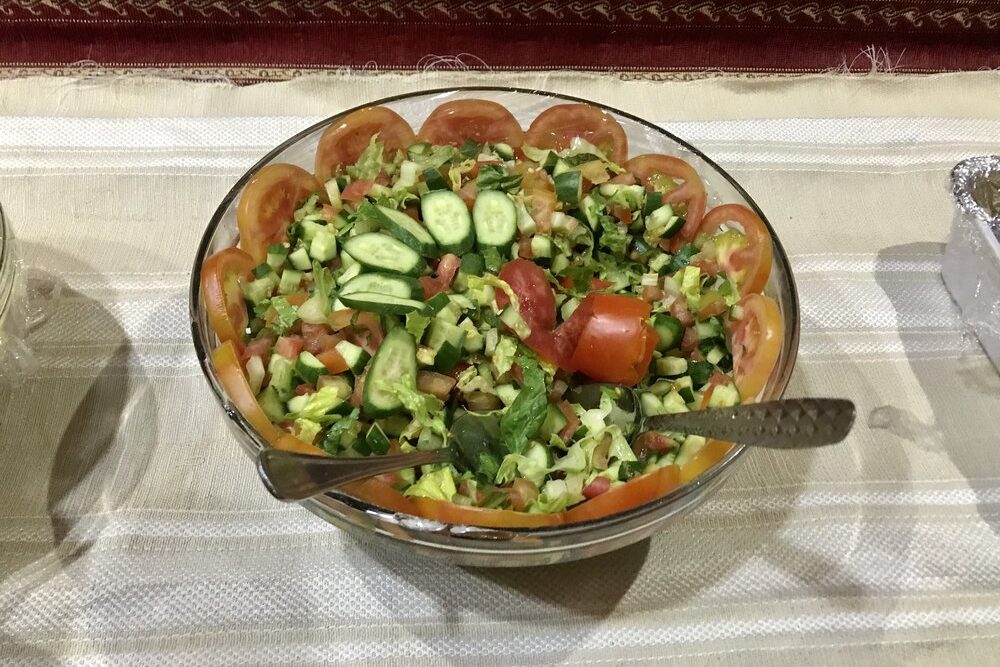
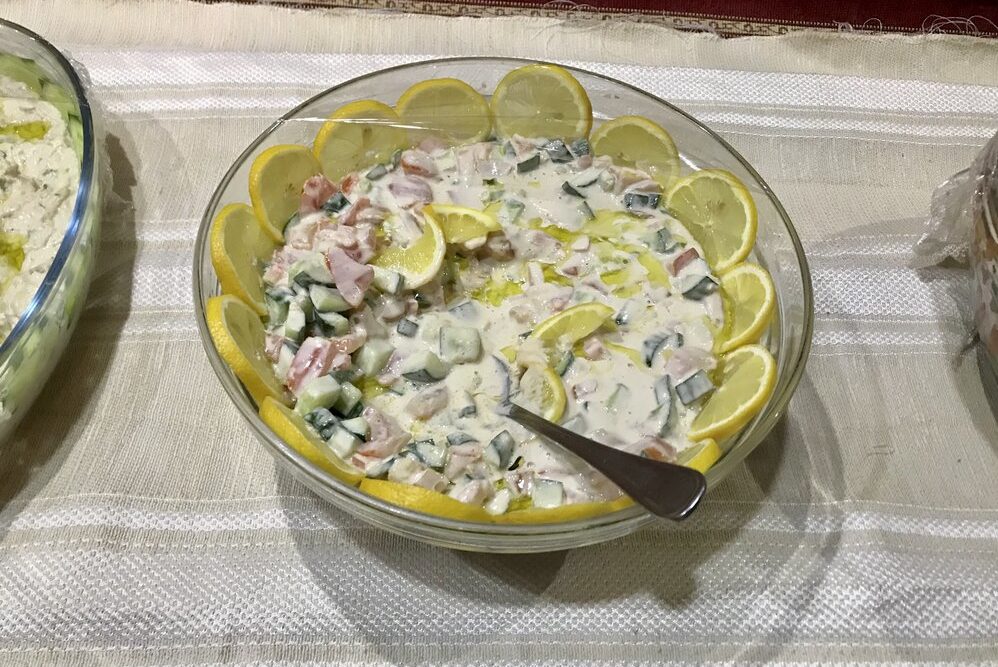
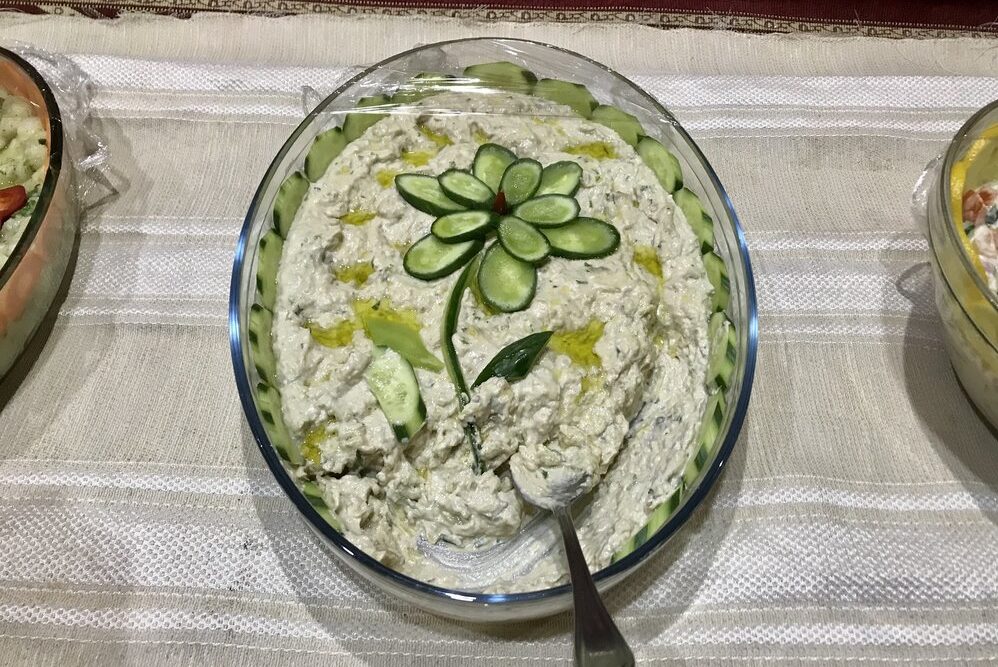

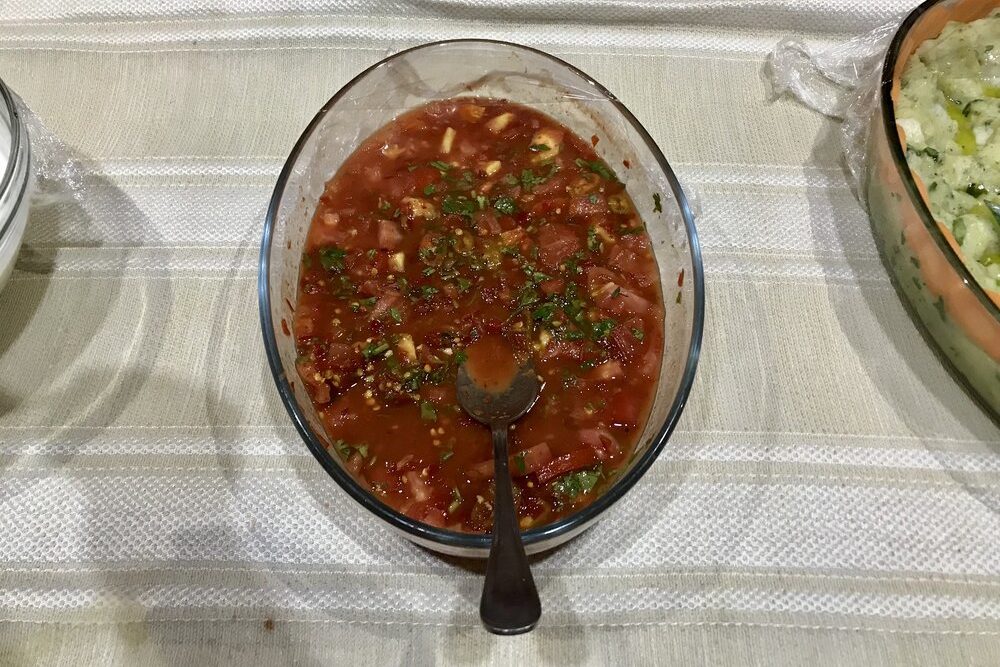
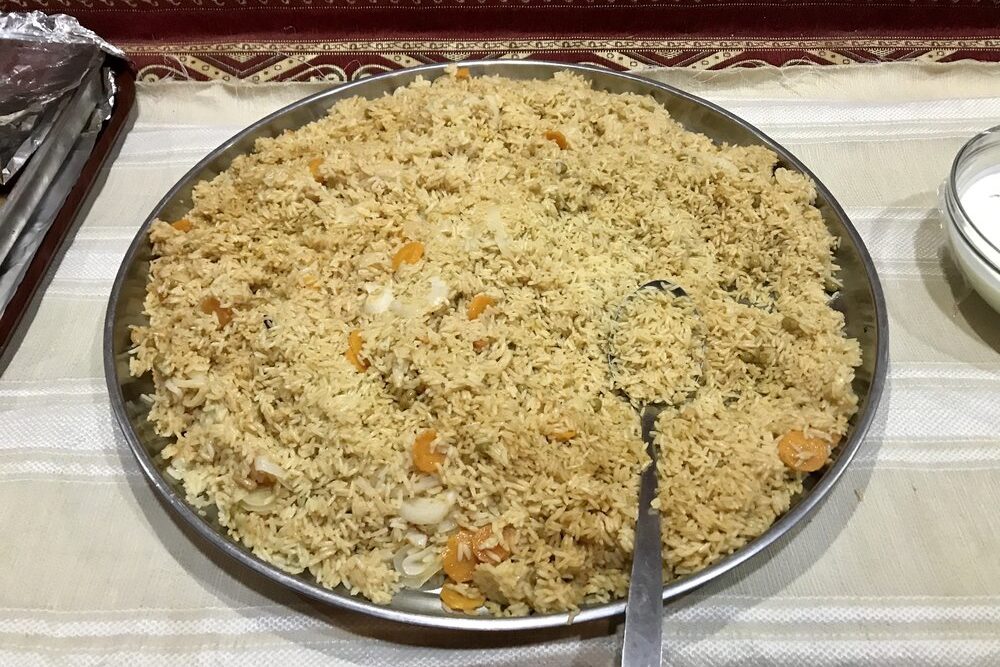
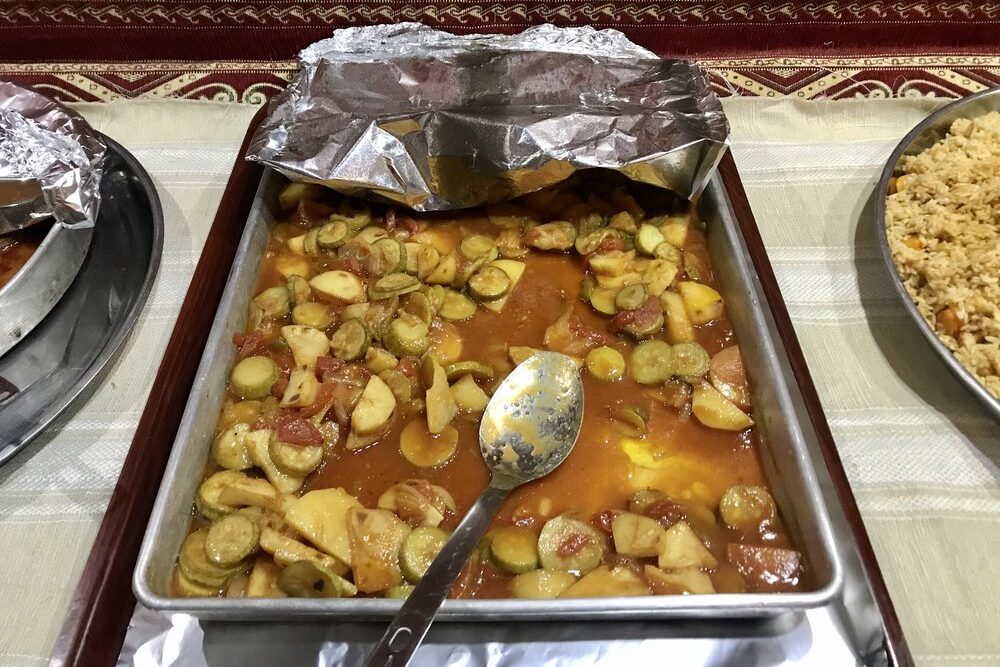
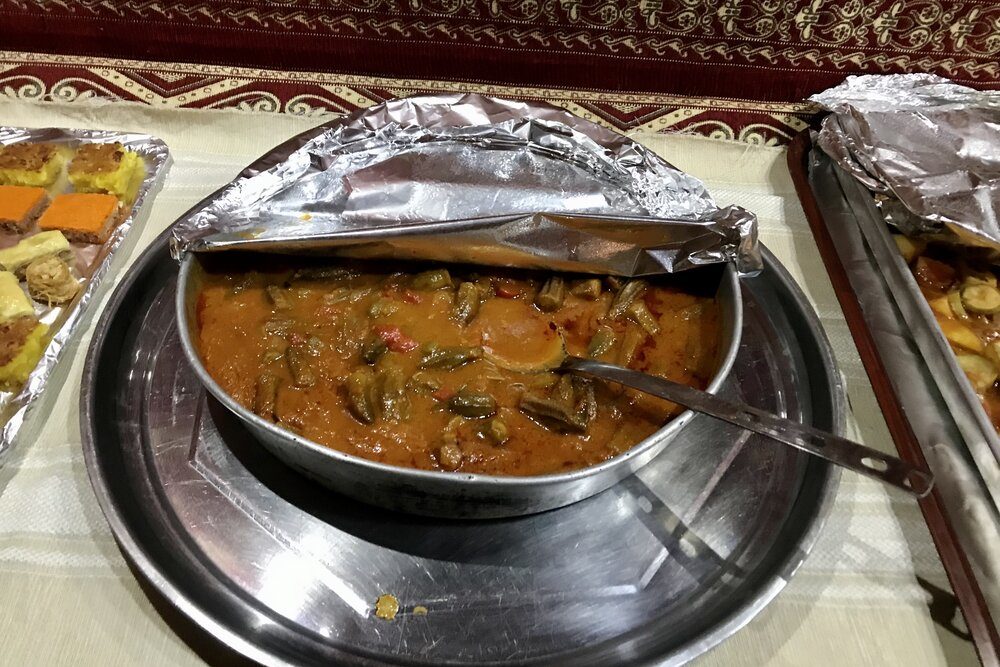












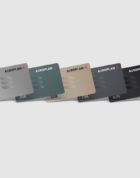

We decided to do the Wadi Rum Bedouin camp you wrote about based on your review and reviews I read in tripadvisor.com. It was my favourite experience in Jordan as well. We paid 120JOD for the night (2 adults and 2 kids) in one tent. We looked at doing the dome tents but couldn’t find any under 250 (or about $500 cad) for the night for the four of us. So with dinner included we thought 120JOD was a fair price. Unfortunately it was cloudy in the evening so couldn’t see any stars, but the landscape, the quietness at the camp and the home cooked feel of the meal was great.
We did a half day jeep tour and it was plenty long enough for us. Personally I wouldn’t want to do more but the half day we got to snowboard, hike, see the canyons and drive through some beautiful areas.
Great write-up! We also happened stayed with Mohamed (this June) . Still haven’t decide what’s better between Bedouin tea paring with Zarb, sunset watch from hill, camel herding or staring at the endless stream of dazzling stars.
You should check out some of the desert areas in Utah/Colorado/Arizona/Nevada/California. The images here remind me a bit of Hole-in-the-Wall area of Mojave desert, and there were some seriously inspiring – and very remote – parts of Vermillion Cliffs in Arizona that are mind blowing. I’m still looking forward to exploring more of that region.
Thank you for covering Jordan. Wadi Rum is a very special place with unique topography and beautiful colour. Our tour with a local guide took us to where they shot The Martian movie with Matt Damon. Pretty cool. Ricky we found the locals very generous and went out of their way to help us.
It’s a great place for some quiet reflection, that’s for sure. I spent about an hour walking in a straight line away from the camp and then back, and along the way I somehow felt compelled to confront some deep dark secrets by voicing them out loud to no one in particular.
Yeah, to be fair Mohammed at the camp was a real saint in comparison, even helping to negotiate our cab fare to Aqaba, which has a well-published price of 30 JD, down to 25. Can’t deny it was the overall sense I got throughout Jordan, although now I know to manage my expectations when I return.
I just love that someone took the time to type this out. Stick around my friend, you won’t want to miss it when I inevitably skirmish with a taxi driver on a 4 hour layover in the DR Congo.
You should try Namibia soon if you like the desolate landscape thing.
One thing that stuck with me from Wadi Rum was the sound of silence. I only heard the sound of my blood moving through my body.
Great write-up. I, like you, don’t take well to people such as the driver you mentioned. I had similar experiences in Morocco; Tangier in particular was absolutely hellish, whereas our hotel/riad owners in Fez ensured we had the best time possible, and were taken care of by all the local shops and owners; not once did we get the sense of tourist price discrimination.
Would love to see more evening pictures, as I find that time of day, and level of Sun light is absolutely beautiful – especially for desert environments.